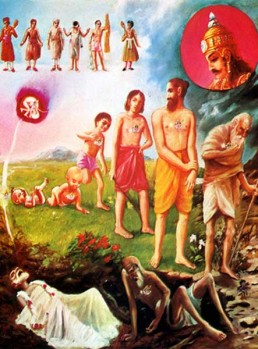Swami Chinmayananda Commentary
This and the following stanzas are arguments in which the materialists’ point-of-view has been, for the purpose of argument, presented here by Krishna. According to them, direct perception alone is an authority for belief. With this standard for their knowledge, when they try to measure life, they have to accept it as a constant flux of infinite-births and infinite-deaths. Things are born; and they die away. This whirl-of-birth-and-death is constant. And “this constant change” is life to them. Krishna argues that, if life is but a constant repetition of births and deaths, then also, the hero (Mahabahu) that you are, you do not deserve to grieve on this occasion.
ACCORDINGLY:
Adi Sankara Commentary
This (verse), ‘On the other hand,’ etc., is uttered assuming that the Self is transient. Atha ca, on the other hand, if (– conveys the sense of assumption –); following ordinary experience, manyase, you think; enam, this One, the Self under discussion; is nityajatam, born continually, becomes born with the birth of each of the numerous bodies; va, or; nityam, constantly; mrtam, dies, along with the death of each of these (bodies); tatha api, even then, even if the Self be of that nature; tvam, you; maha-baho, O mighty-armed one; na arhasi, ought not; socitum, to grieve; evam, thus, since that which is subject to birth will die, and that which is subject to death will be born; these two are inevitable.
The Bhagavad Gita with the commentary of Sri Sankaracharya – Translated by Alladi Mahadeva Sastry
Holy Geeta – Commentary by Swami Chinmayananda
The Bhagavad Gita by Eknath Easwaran – Best selling translation of the Bhagavad Gita
The Bhagavad Gita – Translation and Commentary by Swami Sivananda
Bhagavad Gita – Translation and Commentary by Bhaktivedanta Swami Prabupadha
Srimad Bhagavad Gita Chapter 2 – Verse 26 – 2.26 atha chainam – All Bhagavad Gita (Geeta) Verses in Sanskrit, English, Transliteration, Word Meaning, Translation, Audio, Shankara Bhashya, Adi Sankaracharya Commentary and Links to Videos by Swami Chinmayananda and others – 2-26

